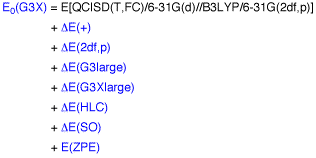G3X Theory
G3X is an improvement over G3 theory in several ways and tries to improve on some weak points of
G3 theory. Important changes are the use of B3LYP/6-31G(2df,p) geometries and the use of larger basis
sets for second row elements (beyond Al). The G3 energy at 0 degrees Kelvin
E0(G3X) is defined as:

The definition of the components being:






The necessary energies can be calculated most efficiently in the following sequence:
- Optimization and frequency calculation at the B3LYP/6-31G(2df,p) level of theory
- QCISD(T,FC)/6-31G(d)//B3LYP/6-31G(2df,p) single point
- MP4(FC)/6-31+G(d)//B3LYP/6-31G(2df,p) single point
- MP4(FC)/6-31G(2df,p)//B3LYP/6-31G(2df,p) single point
- MP2(Full)/G3large//B3LYP/6-31G(2df,p) single point
- HF/G3Xlarge//B3LYP/6-31G(2df,p) single point (for second row elements only)
Comments:
- The G3large basis set is identical to the one used in G3 theory. The G3Xlarge basis set
used for the Hartree-Fock calculations adds g-type polarization functions to the G3large basis
set for elements beyond Al. These extended basis sets can be found on the G3X theory
web site set up by Larry Curtiss. A local copy can be found here.
- Open shell systems are treated using unrestricted wavefunctions (UHF, UMP2 . . )
- The higher level correction (HLC) is supposed to compensate for the remaining deficiencies
of the method. As in G3 theory, different parameters A and B are used for atoms and molecules
to give the smallest average absolute deviation from experiment.
- Spin orbit correction terms E(SO) (mainly of experimental origin) are added only for atoms
- The mean absolute deviation for the G3/99 test set (376 data points) is
1.07 kcal/mol for G3 and 0.95 kcal/mol for G3X theory.
Literature:
- L. A. Curtiss, K. Raghavachari, P. C. Redfern, V. Rassolov, J. A. Pople,
"Gaussian-3 (G3) theory for molecules containing first and second-row atoms"
J. Chem. Phys. 1998, 109, 7764 - 7776.
- L. A. Curtiss, K. Raghavachari,
"G2 Theory"
The Encyclopedia of Computational Chemistry, P. v. R. Schleyer (editor-in-chief),
John Wiley & Sons Ltd, Athens, USA, 1998, 2, 1104 - 1114.
- L. A. Curtiss, P. C. Redfern, K. Raghavachari, V. Rassolov, J. A. Pople,
"Gaussian-3 theory using reduced Møller-Plesset order"
J. Chem. Phys. 1999, 110, 4703 - 4709.
- A. G. Baboul, L. A. Curtiss, P. C. Redfern, K. Raghavachari,
"Gaussian-3 theory using density functional geometries and zero-point energies"
J. Chem. Phys. 1999, 110, 7650 - 7657.
- L. A. Curtiss, P. C. Redfern, K. Raghavachari, J. A. Pople
"Gaussian-3X (G3X) theory: Use of improved geometries, zero-point energies, and Hartree-Fock basis sets"
J. Chem. Phys. 2001, 114, 108 - 117.
last changes: 01.04.2008, AS
questions & comments to: axel.schulz@uni-rostock.de


